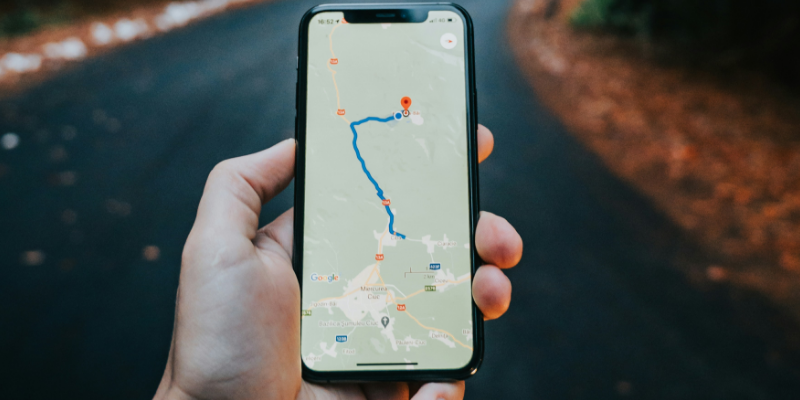Making sense of our connected world

Navigating the urban maze: GIS technology and the blurring boundaries between digital and physical infrastructure
Introducing the progression of geographic information systems (GIS) technology and its varied applications, we provide an entry point to the debate on whether digital maps should be treated akin to physical public infrastructure, given their critical role in private and public decision-making. Examining the risks and dependencies created by proprietary geodata services, we call for a re-evaluation of digital maps in the public utility and governance framework.
Geographical data utilisation in urban spaces
21st-century metropolises increasingly face an omnipresence of mobile cyber-physical systems (CPS). Such systems integrate computational and physical processes to effectively monitor urban spaces, blurring the boundaries between the physical and digital worlds (Lee, 2008). Common public use cases for CPS include city-wide functions, such as infrastructure planning or managing public transportation. Private entities also utilise CPS, such as digital maps and geodata collection for food delivery, restaurant recommendations or travel planning. However, although they are frequently used by both public and private entities, the most prominent CPS have been developed by a small handful of private companies.CPS-based monitoring can involve passive data extraction modalities, like utilising real-time data from stationary cameras in public transport systems, or active control modalities, such as intelligent traffic light systems for optimising traffic flow. One area where passive data collection and active control come together to create real-time digital representations of urban spaces is in geographic information systems (GIS) (University of Wisconsin-Madison, 2024). This is made possible by computers that are scaled down to the point where they can be embedded in everyday objects and activities and by advances in sensing and computing power, all of which allow for the ubiquitous integration of increasingly capable microelectronics (Kandt & Batty, 2021).
How did we get here, a very brief history
Today, GIS technology and geodata-based maps are dominated by private actors. Products like Google Maps, Apple Maps and Baidu Maps divide up the market for consumer applications. At the same time, HERE and TomTom extend the range for integrable solutions in the business-to-business (B2B) and business-to-public (B2P) sectors.
The genesis of the GIS industry can be traced back to the early 1960s, a pivotal moment when the confluence of computer science, geography and cartography gave birth to a new way of analysing and visualising geographical data. During the 60s, the pioneering work by Roger Tomlinson – often hailed as the “Father of GIS” – on the Canada Geographic Information System, laid the foundations for GIS by introducing the concept of overlaying various datasets on a digital map for comprehensive spatial analysis (AAG, 2024).
This innovation marked the beginning of a transition from traditional, manual cartography to digital mapping techniques, leveraging the burgeoning power of computer technology to process and analyse spatial data. It also opened up mapping operations, which had previously been subject to restrictive control by the public sector, to private companies.
Throughout the 1970s and 1980s, the GIS industry benefited from rapid advances in computer technology, including the development of more sophisticated software, and the introduction of user-friendly interfaces, which made GIS tools more accessible to a broader audience. The establishment of the Environmental Systems Research Institute (Esri) in 1969 by Jack and Laura Dangermond propelled the industry forward, with Esri’s ArcGIS becoming a cornerstone technology in the field. Another pioneer, Open Street Maps (OSM) emerged in 2004 as an open-access map alternative, integrating crowdsourcing as its primary medium for data acquisition and validation.
The advent of the internet, smart mobile devices and the proliferation of GPS technology in the late 20th and early 21st centuries further revolutionised the GIS industry, enabling real-time data collection and expanding the application of GIS across diverse fields, such as private transportation, logistics, and workplace surveillance. The contemporary GIS industry continues to evolve with advances in cloud computing, big data analytics and artificial intelligence. This underlines its critical role in addressing complex spatial challenges and shaping decision-making processes across the globe.
The interlinking of public and private actors permeates the entire geospatial data ecosystem. Most GIS providers of proprietary digital maps, like Google or Apple, extensively incorporate publicly available data while also influencing how societal actors, be they public authorities or citizens, navigate physical spaces. These companies also allow users to contribute and add contextual data, thereby shaping users’ geographical choices and behaviour. Esri is expanding its worldwide partnerships with cities and communities to connect proprietary mapping data – despite open-source alternatives (Anselin et al., 2009).
Opening a debate on treating digital maps as public infrastructure
Because public data is significant and maps impact the public’s daily lives, we want to initiate a debate on the extent to which digital maps can or should be considered digital public infrastructure, incorporating both GIS technology and geodata (Eaves & Sandman, 2023). We attribute a public component to the creation, governance and exploitation of physical maps, which have always been tied to geographic sovereignty issues and the public sector’s authority. In our view, this is no less the case with digital maps.
Regarding the infrastructure component, we share Brett Frischmann’s (2012) view of infrastructure as a “shared means to many ends”. For example, roads (the shared means) are a common way to transport individuals or goods for various purposes — to get to hospitals, schools, supermarkets or anywhere else for any reason (the many ends). Similarly, a digital map is a means of finding the road mentioned above and thus the way to the final destination. Public authorities oversee road construction, substantially influence traffic flow and are interested in providing their citizens with accessible and sustainable urban mobility.
However, public authority and citizens’ sovereignty may be at risk if digital map providers utilise proprietary black-box algorithms (Abadi & Berrada, 2018) to collect and collate data in a non-traceable way to compile recommendations. Because they are owned by private companies, such as Google, Apple or Baidu, digital maps can also be taken offline, altered or restricted based on corporate interests – an inherent unreliability and unpredictability that precludes the infrastructural resilience demanded of public infrastructure.
Emerging discussions about mapping the supply chain of digital services demonstrate that digital maps should not be the sole object of discussion given that they are only the final result of geodata processing. Rather, the entire process should be examined, beginning with the question of suitable geodata sources, collection procedures and integration workflows (Law et al., 2018). We are left, therefore, with three pressing questions: How did digital mapping services develop over time to become quasi-public digital infrastructure? To what extent are current private and public digital services reliant on (a small number of) privately owned digital mapping/GIS services? Will the digital mapping ecosystem expand in the future with a greater variety of services, ownership and business models, or will we witness increasing concentration and monopolisation? In our ongoing research, we are attempting to provide answers and actionable insights.
Authors
Philip Meier is an associated researcher at the Alexander von Humboldt Institute for Internet and Society (HIIG).
Dr. Gemma Newlands is a departmental research lecturer in AI & Work at the Oxford Internet Institute. As an organisational sociologist, her research explores the impact of artificial intelligence on work and organisations, with a particular focus on issues of surveillance and visibility.
References
AAG (2024). Roger Tomlinson. Retrieved from https://www.aag.org/memorial/roger-tomlinson-1933-2014/
Adadi, A., & Berrada, M. (2018). Peeking inside the black box: a survey on explainable artificial intelligence (XAI). IEEE access, 6, 52138-52160.
Anselin, L., Syabri, I., & Kho, Y. (2009). GeoDa: an introduction to spatial data analysis. In Handbook of applied spatial analysis: Software tools, methods and applications (pp. 73-89). Berlin, Heidelberg: Springer Berlin Heidelberg.
Eaves, D., & Sandman, J. (2023). What is digital public infrastructure?. UCL IIPP Blog. Retrieved from https://medium.com/iipp-blog/what-is-digital-public-infrastructure-6fbfa74f2f8c
Frischmann, B. M. (2012). Infrastructure: The social value of shared resources. New York.
Kandt, J., & Batty, M. (2021). Smart cities, big data and urban policy: Towards urban analytics for the long run. Cities, 109, 102992.
Law, S., Seresinhe, C. I., Shen, Y., & Gutierrez-Roig, M. (2020). Street-Frontage-Net: urban image classification using deep convolutional neural networks. International Journal of Geographical Information Science, 34(4), 681-707.
Lee, E. A. (2008, May). Cyber physical systems: Design challenges. In 2008 11th IEEE international symposium on object and component-oriented real-time distributed computing (ISORC) (pp. 363-369). IEEE.
University of Wisconsin-Madison (2024). Mapping and Geographic Information Systems (GIS) : What is GIS?. Retrieved from https://researchguides.library.wisc.edu/GIS
This post represents the view of the author and does not necessarily represent the view of the institute itself. For more information about the topics of these articles and associated research projects, please contact info@hiig.de.

You will receive our latest blog articles once a month in a newsletter.
Data governance
Escaping the digitalisation backlog: data governance puts cities and municipalities in the digital fast lane
The Data Governance Guide empowers cities to develop data-driven services that serve citizens effectively.
Online echoes: the Tagesschau in Einfacher Sprache
How is the Tagesschau in Einfacher Sprache perceived? This analysis of Reddit comments reveals how the new simplified format news is discussed online.
Opportunities to combat loneliness: How care facilities are connecting neighborhoods
Can digital tools help combat loneliness in old age? Care facilities are rethinking their role as inclusive, connected places in the community.





